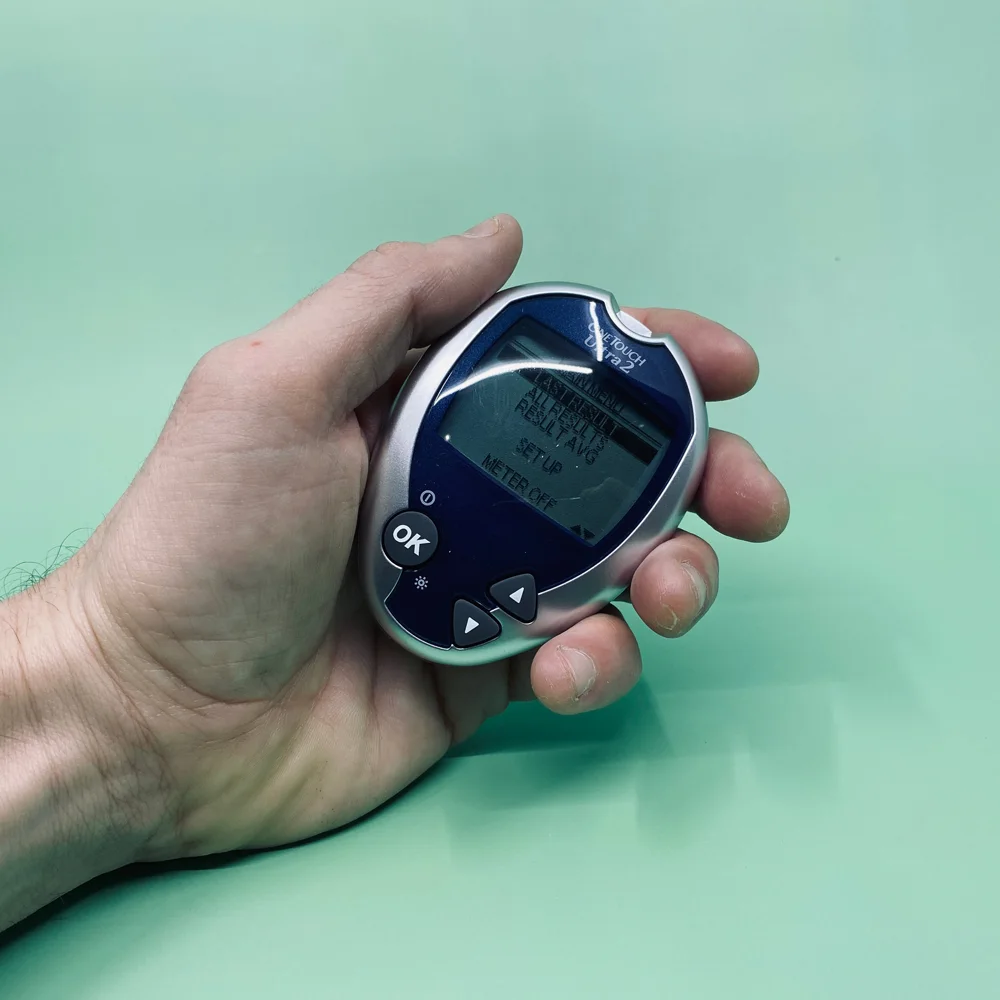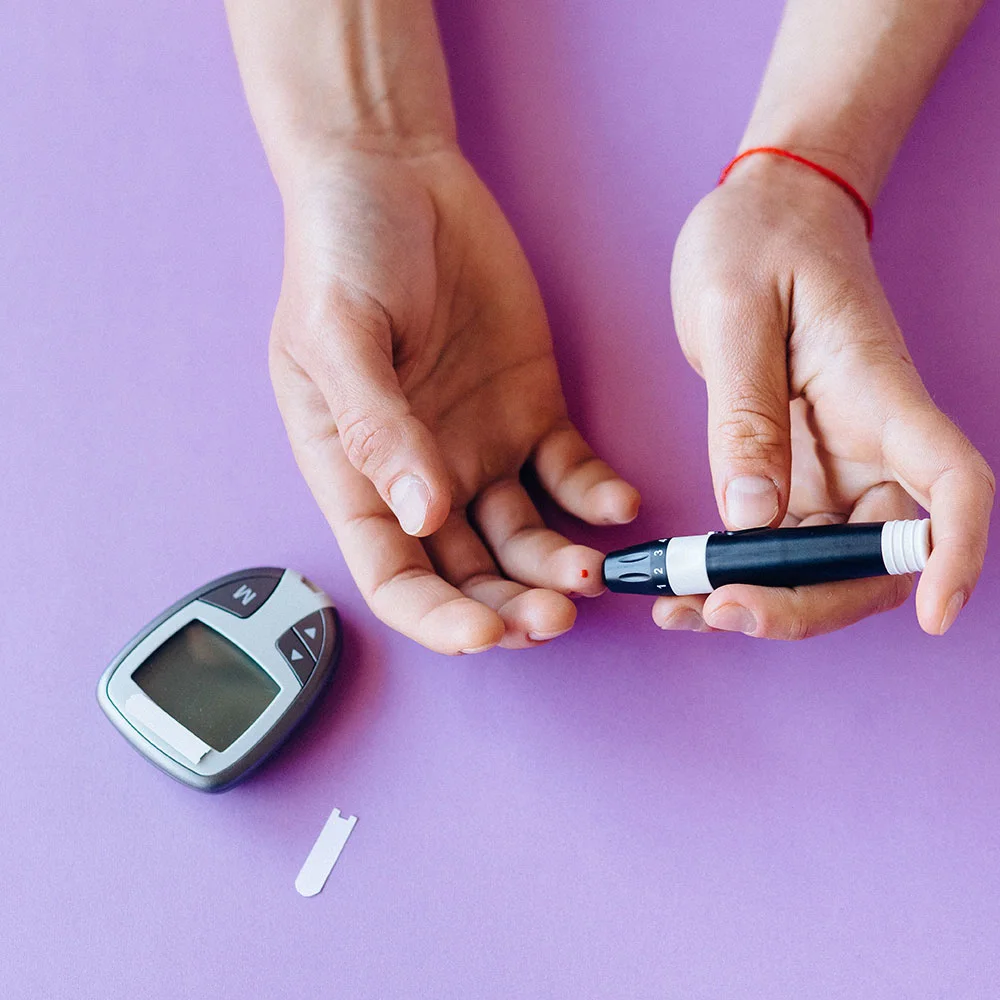Here's what we'll cover
Here's what we'll cover
Here's what we'll cover
If you have a sweet tooth or have ever craved a piece of fruit or dessert, you know the body loves sugar. In fact, our bodies are wired to love sugar. Sugar is humans preferred fuel source as the breakdown of sugar is one of the most important ways the cells in the body get energy. The body is also able to break down fats and proteins for energy (fats actually contain the most energy per unit), but neither of these produces energy as quickly as sugar.
Blood sugar refers to the sugar that is flowing around in the blood. However, to better understand what this means, it’s helpful to define what precisely a “sugar” is and what it does in the body.
What is sugar?
Although you may think of sugar as just one thing, there are actually many different types of sugars. Sugars, recognized by the suffix “-ose,” are also called saccharides and are classified based on their chemical structures.
Monosaccharides
The “simple sugars” are the smallest sugars and are called monosaccharides.
Simple sugars include:
Fructose: This is the sugar found in fruits and corn syrup.
Galactose: This is one of the sugars found in dairy products.
Glucose (also called dextrose): This is the type of sugar created by plants during photosynthesis. Most larger sugars are broken down into glucose in the body, and glucose is the main form of sugar that flows through the bloodstream.
Disaccharides
The “compound sugars” are made up of two simple sugars put together and are called disaccharides.
Compound sugars include:
Lactose: This sugar is made up of one molecule of galactose and one molecule of glucose linked together. It is the sugar found in milk and digesting it requires a specific enzyme called lactase. If you don’t have enough of that enzyme, you are said to be lactose intolerant.
Maltose: This sugar is made up of two molecules of glucose linked together. It comes from certain grains.
Sucrose: This sugar is made up of one molecule of fructose and one molecule of glucose linked together. It comes from sugarcane and is the type of sugar that makes up table sugar.
Polysaccharides
Large chains of monosaccharides are called polysaccharides. Another name for polysaccharides is complex carbohydrates. Therefore, when you eat complex carbohydrates, you are eating long chains of sugars.
Important types of complex carbohydrates are:
Cellulose: This is a chain of many glucose molecules that helps provide structure to plant cells. It cannot be broken down or digested by humans and is, therefore, a type of insoluble (non-dissolvable) dietary fiber.
Glycogen: This is a chain of many glucose molecules and is the main way that the human body stores energy. Glycogen is primarily located in the liver and in the muscles. When there is excess glucose in the body, it gets stored as glycogen for future use. When there is not enough glucose in the body, glycogen is broken down into glucose to provide more.
Starch: This is a chain of many glucose molecules and is the main way plants store energy. As a result, it is also the most common carbohydrate in the human diet. The difference between cellulose, glycogen, and starch is the way glucose molecules are linked together, which is different in all three.
Whenever you eat a complex carbohydrate or compound sugar, it is first broken down by the body into simple sugars (unless the carbohydrate is like cellulose and cannot be digested). These simple sugars (the majority of which are glucose) are carried around in the blood to your cells where they are further broken down into smaller pieces and metabolized for energy. The end result of sugar metabolism is energy, water, and carbon dioxide.
What are blood sugar levels?
When healthcare professionals talk about blood sugar levels, they are talking about the measured amount of sugar that is flowing around in the blood. Blood is the primary transport mechanism of the body, and all of the vitamins, nutrients, oxygen, and water that your cells need come from the circulating blood. Glucose is the measured form of sugar in the blood, so “blood sugar” is synonymous with “blood glucose.” The word “plasma” is also sometimes used in place of “blood” when describing these levels. (If you were to remove all of the blood cells and all of the components related to clotting from the blood, what you’re left with is plasma). Therefore, “plasma glucose” means the same thing as “blood sugar” and “blood glucose.”
How does food affect blood sugar levels?
Different foods impact your blood sugar differently. The glycemic index of a food is a measure that represents how quickly the carbohydrates in that food are broken down and affect blood glucose. The glycemic index is a scale from 1—100, with 100 having the biggest effect (pure glucose has a score of 100). Low glycemic index foods range from 1—55 and include beans, fruits, legumes, and non—starchy vegetables. Medium glycemic index foods range from 56—69 and include brown rice and whole wheat bread. High glycemic index foods range from 70—100 and include cereal, melons, potatoes, white bread, and white rice.
Because the glycemic index does not take into account how many carbohydrates you actually eat, a related value called the glycemic load is sometimes used. Glycemic Load = (Glycemic Index X Grams of Carbohydrates)/100. Low glycemic load foods have a score ranging from 0—10, medium glycemic load foods have a score ranging from 11—19, and high glycemic load foods have a score of 20+. Sometimes the glycemic load parallels the glycemic index, and sometimes the values are different. For example, watermelon has a high glycemic index but a low glycemic load because the actual number of carbohydrates ingested is low. People with diabetes may want to pay attention to the glycemic index and glycemic loads of the foods they eat for optimal blood sugar control.
How is blood sugar regulated in the body?
Blood sugar is regulated in the body by several hormones. The two most important hormones that impact blood sugar levels are glucagon and insulin. The pancreas releases these hormones. The pancreas is an organ that sits behind the stomach and acts as part of both the digestive system and the endocrine system. Many of these terms are similar and can get confusing. As a reminder:
Glucose = A simple sugar
Glycogen = A polysaccharide that is a storage form of glucose in the body
Glucagon = A hormone released by the pancreas that helps control blood sugar levels
Glucagon
Glucagon is the primary hormone that helps to raise blood sugar levels. When levels are too low, it stimulates alpha cells in the pancreas to release glucagon. Glucagon then acts on the liver, prompting the breakdown of glycogen into glucose. The newly released glucose enters the bloodstream, raising blood sugar levels.
Insulin
Insulin is the primary hormone that helps to lower blood sugar levels. When levels are too high, it stimulates beta cells in the pancreas to release insulin. Insulin then acts in two ways. First, insulin promotes the uptake of glucose by fat and muscle cells. Second, insulin acts on the liver, prompting the storage of glucose in the form of glycogen — these two actions of insulin help to lower blood sugar levels.
What are normal blood sugar values?
In the body, blood sugar levels are tightly regulated. This is because having a blood sugar level that is either too high or too low can be dangerous for your health. When you eat food, blood sugar levels rise, but as glucose is moved into cells to be used for energy or stored in the form of glycogen, blood sugar levels come back down again. Blood sugar levels are therefore classified as either fasting blood sugar levels (when you haven’t eaten or drunk anything for at least eight hours) or non-fasting blood sugar levels.
In a healthy individual, the normal range is:
Normal fasting blood sugar levels are 70–99 mg/dL
Normal blood sugar levels two hours after eating are <140 mg/dL
Blood sugar levels that are outside of these ranges can be used to diagnose diabetes or prediabetes.
What is hypoglycemia (low blood sugar)?
Hypoglycemia is a term for low blood sugar, which occurs when blood glucose levels fall below 70 mg/dL. While hypoglycemia typically occurs in the context of diabetes, it is also possible for people without diabetes to get hypoglycemia as well.
The symptoms of hypoglycemia include anxiety, dizziness, fatigue, headache, irregular heartbeat, shakiness, and sweating. However, hypoglycemia can be very dangerous and may progress to changes in vision, confusion, seizures, loss of consciousness, and death. It is important to recognize hypoglycemia as quickly as possible and to act on it.
What is hyperglycemia (high blood sugar)?
Hyperglycemia refers to high blood sugar. While persistent hyperglycemia has many long-term effects, hyperglycemia typically doesn’t produce obvious symptoms unless blood sugar levels are higher than 180 mg/dL for a prolonged period. When this happens, symptoms may include headache, fatigue, frequent urination, thirst, and vision changes.
In diabetes, hyperglycemia may lead to diabetic ketoacidosis (DKA) or hyperosmolar hyperglycemic state (HHS). In both of these conditions, blood glucose levels are markedly elevated, and severe symptoms may occur, including confusion, fever, loss of consciousness, seizures, and vision loss. These conditions are emergencies requiring immediate medical treatment.
How are blood sugar and diabetes connected?
Type 1 diabetes and type 2 diabetes are disorders with how the body makes or responds to insulin, one of the two hormones that regulate blood sugar. As a result, blood sugar levels in diabetes are uncontrolled.
According to the American Diabetes Association, diabetes can be diagnosed if one of the following is true:
Plasma glucose is ≥126 mg/dL after you have fasted for 8 hours. This needs to be confirmed more than once.
Plasma glucose is ≥200 mg/dL when taken randomly, in combination with symptoms of diabetes.
Plasma glucose is ≥200 mg/dL during an oral glucose tolerance test (OGTT), which includes administering 1.75 g/kg of glucose by mouth.
Hemoglobin A1C, a blood test that gives a reasonable estimate of blood sugar levels over the prior two to three months, is ≥6.5.
Prediabetes can also be diagnosed if one of the following is true:
Plasma glucose is 100–125 mg/dL after you have fasted for 8 hours.
Plasma glucose is 140–199 mg/dL during an oral glucose tolerance test (OGTT).
Hemoglobin A1C is 5.7–6.4.
How do you test blood sugar levels?
Blood sugar levels are checked with a blood test. If you are in a healthcare provider’s office or another healthcare setting, blood drawn from a vein or from an artery can indicate blood sugar level. However, it’s more common for blood sugar can be checked with a fingerstick. A fingerstick involves making a tiny pinprick on the end of the finger with a lancet, drawing the blood out, and checking the blood sugar levels in a machine called a glucometer. Glucometers can determine your blood sugar level within a matter of seconds, and they are an extremely useful tool for anyone with diabetes.
Continuous glucose monitors are also now available. Continuous glucose monitoring systems involve a wearable or implantable sensor that tracks your blood glucose in real-time. These results are easily viewable on a device such as a smartphone and can help people with diabetes maintain even better glucose control.
DISCLAIMER
If you have any medical questions or concerns, please talk to your healthcare provider. The articles on Health Guide are underpinned by peer-reviewed research and information drawn from medical societies and governmental agencies. However, they are not a substitute for professional medical advice, diagnosis, or treatment.












